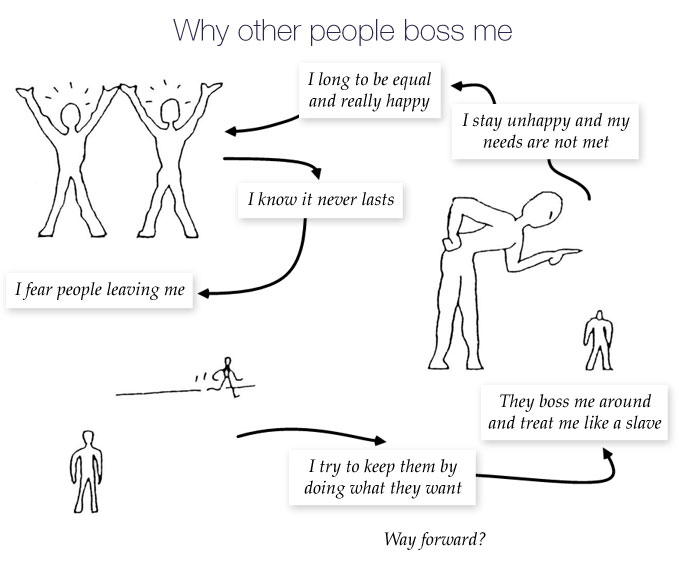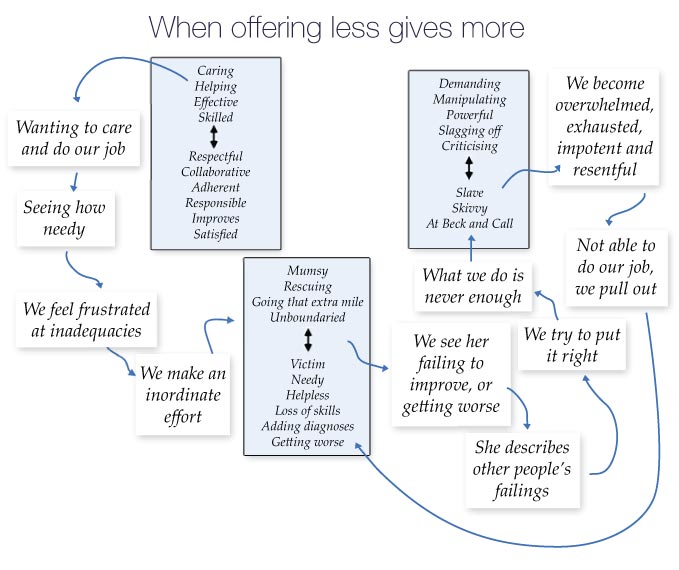CAT with people with a learning disability
 The Government’s White Paper ‘Valuing People’ (2001) states that people with learning disabilities should have the same access to services as everyone else. Over the last 15 years, a range of therapies have been offered but sporadically, and the provision of CAT in the NHS in services for people with learning disabilities is similarly patchy. However, CAT is proving popular because its relational approach means that, unlike many psycho-educational therapies, CAT does not need to rely on a relatively high level of verbal ability or psychological mindedness. CAT with people with learning disabilities does involve playing close attention to where the client is at in their emotional, functional, and relational approach to life as well as their place in wider society, but of course, this is also true when working with people of average intelligence.
The Government’s White Paper ‘Valuing People’ (2001) states that people with learning disabilities should have the same access to services as everyone else. Over the last 15 years, a range of therapies have been offered but sporadically, and the provision of CAT in the NHS in services for people with learning disabilities is similarly patchy. However, CAT is proving popular because its relational approach means that, unlike many psycho-educational therapies, CAT does not need to rely on a relatively high level of verbal ability or psychological mindedness. CAT with people with learning disabilities does involve playing close attention to where the client is at in their emotional, functional, and relational approach to life as well as their place in wider society, but of course, this is also true when working with people of average intelligence.
CAT is particularly helpful for people with learning disabilities owing to its clear processes and structure; especially its time-limited nature and focus on endings, all of which can be clearly described. “The transparency of the CAT model gives the therapist a structure in which to acknowledge the most basic and difficult reality for people with learning disability in a way that is containing for both the client and therapist.” (Bancroft et al, 2008). Its collaborative nature is important as typically in learning disability services, referrals do not come from the client themselves.
This does not imply there are no changes required when offering CAT to people with learning disabilities. Some changes are relatively superficial, such as using accessible and adapted tools, (developed and available from the CAT LD special interest group) but also within therapy, using drawing and audio taping prose letters, as well as extending the assessment period and slowing down the pace of therapy, rather than altering its course. Some developments in the CAT model are more central, particularly using CAT’s systemic approaches, in order to work with staff teams, especially when teams work with people with challenging behaviour. The aim is to use CAT to help move patterns of relationships from those that unwittingly reinforce negative behaviours to ones that are more relationally intelligent and productive.
There is a growing body of evidence about the effectiveness of CAT for people with learning disabilities and their carers. Over 20 studies have been published; many single-case reports, but also research into the efficacy of some of the basic ideas in CAT when applied to this population. Much of this evidence has been gathered by the CAT LD special interest group, which involves workers from two environments: Forensic and Community.
A brief case vignette describing working with a community client (therapist Julie Lloyd, supervisor Val Crowley).
The client’s was referred for low mood following bereavement two years earlier. As the therapy developed, the reason for her continued unhappiness became clearer. She was worried about losing the remaining people in her life, which led her to let them walk all over her, treating her with scant regard for her needs and wishes. We drew this map describing the situation and over time, the client started to make a wider circle of friends and to say ‘no’ to unreasonable demands.

A brief case vignette describing team working about a community client (therapist Julie Lloyd, supervisor Val Crowley).
A referral was received for a ‘hard to help’ client with a learning disability and complex physical and mental health needs, including a severe borderline personality disorder. The difficulty was that the client was steadily deteriorating despite intense input from a range of agencies including the G.P. surgery, district nursing, care management, support workers, community nursing and other health professionals. On an objective level, she clearly was very needy owing to her serious health issues, but she sabotaged any attempts to collaborate in her treatment, determined to stay as sick and needy as possible. She would endlessly invite individual professionals to rescue her by treating them as ‘special carers’, but complain about them behind their backs to other professionals, who were similarly invited to be the special one. Workers were aware that this could cause splitting amongst themselves, but were at a loss to know how much help to offer her. At a meeting with the multi-agency team, the CAT therapist worked with the team to map out the situation.

The CAT therapist went on to attend further meetings with people involved in the client’s care in addition to seeing the client, with the aim of exploring what it was about the relationships that was blocking the aim of ‘working with’ instead of ‘doing for’. This work helped staff to avoid either getting into a rescuing role that colluded with the client’s perception that she could only buy relationships through demanding care, or to get into an abandoning role by giving up and avoid her; old patterns familiar to the client from her early life. Staff also decided that whenever she complained about a third person, they would no longer pass on messages, but encourage her to talk to the person directly.
CAT in Forensic services for people with learning disabilities
CAT in forensic intellectual disability services is becoming an established and well utilised model in the treatment of offenders. There are publications including case study research papers that support the clinical assertion that CAT is accessible to people who have an intellectual disability and that the applicability of CAT formulations are invaluable within the context of secure institutions.
These institutions may indeed replicate the difficult experiences individuals have encountered previously in their lives. Such relational enactments are common in secure services and CAT as a relational model is very well placed to help staff groups understand the position they may be drawn into and/or the emotional state they are experiencing.
As a therapeutic framework and working model, CAT is adaptable and flexible enough to be represented through a multiplicity of media tools and language whilst maintaining the core focus on relationships. As in all relationships in context, CAT in forensic settings is no different, except that the intellectual ability of the person may inhibit ‘progress’. Therefore it is necessary to accommodate and factor in the notion of time as a variable which may slow down the journey of therapy and consequently extend the number of sessions required to enable the client to make use of his/her time with the therapist.
Shared care formulations have proven benefits in helping staff teams and the Multidisciplinary Team understand ‘where’ they are in relation to their patients difficulties. Forensic settings are no exception to this premise, indeed there are perhaps advantages to be gleaned from a patient being ‘held’ and ‘contained’ psychologically/emotionally and physically with an understanding being shared by the patient and staff team of what needs to be thought about in terms of enactments.
Offending behaviour has obvious links to the wellbeing of others. Aggression, theft, sexual offending, fire setting, false imprisonment and harassment etc all have real and potentially catastrophic consequences for victims. All offending behaviour can be formulated in terms of reciprocal roles, therefore the clarity and depiction of explicit relationality in offending can be clearly represented in CAT maps. There are of course implications for clarity and this can be thought through in terms of for example; humility and shame, responsibility, entitlement, control etc that patients bring with them. Helping staff teams not to reciprocate (despite this being inevitable) is a learning experience for many staff team members, particularly as patients will often ‘invite’ them in.
These emotional events can often have deleterious effects on individual staff members which can in turn have systematic repercussions, with splitting being in all possibility the most frequent phenomenon. This can in turn lead to an intense lowering of morale and burn out, sometimes of complete staff teams, or a manifestation of extreme reciprocation which can lead to disciplinary procedures being undertaken. There is also the individual staff member and team ‘collective’ reciprocal role which requires the CAT clinician to work through how best to support all involved. CAT skills training is currently a resource which is being accessed by trusts to enable staff teams to manage such reciprocal role enactments. There is of course individual supervisory practice which could help team members’ work through personal issues in relation to patient psychopathology.
‘Valuing People Now’ http://www.valuingpeoplenow.dh.gov.uk
Julie Lloyd
List of relevant articles
Bancroft, A., Collins, S., Crowley, V., Harding, C., Kim, Y., Lloyd, J., Murphy, N. (2008). Is CAT an island or a solar system? The dilemmas in the therapeutic frame when working with people with learning disabilities. Reformulation. 30, 23-25.
Clayton P. (2000). Cognitive Analytic Therapy: learning disability and Firesetting. In Mercer, D., Mason, T., McKeown, M., McCann, G. (Eds). , Forensic Mental Health Care, a Case Study Approach. London, Churchill Livingstone.
Clayton, P. (2006). “The learning disabled offender and the secure institution”. In Pollock, P., Stowell-Smith, M.& Gopfert, M (Eds) Cognitive Analytic Therapy for Offenders: A new Approach to forensic psychotherapy. London: Routledge
Collins, S. (2006). “Don’t Dis me!” Working with young people who have physical and learning disabilities’. Reformulation, 27, 13-15.
David, C. (2009). “CAT and People with Learning Disability: Using CAT with a 17 year old girl with Learning Disability.” Reformulation, 32, 21-25.
Elia, I. (2007). The Inner Voice Check. Reformulation, 28, 28-29.
King, R (2000). CAT and Learning Disability. Reformulation (March edition )
Fisher, C. & Harding, C., (2009) Thoughts on the Rebel Role: Its Application to Challenging Behaviour in Learning Disability Services. Reformulation, 32, 4-5.
King, R, (2005). ‘CAT and the therapeutic Relationship and working with people with learning disability’ Summer Edition Reformulation
Lloyd, J. (2007). Case Study on Z; Not as impossible as we had thought. Reformulation, 31-39.
Lloyd, J. (2009). ‘When Happy is not the only Feeling: Implications for Accessing Psychological Therapy’. Reformulation, 33, 24-25.
Lloyd, J., & Potter, S. “The ‘neurological outsider’: Using relational intelligence to link multiple aspects of autism”. For copies of this paper contact the authors’ email: Julie.Lloyd4@ntlworld.com or Stevegpotter@googlemail.com
Lloyd, J. and Williams, B. (2003). Reciprocal Roles and the Unspeakable Known: Exploring CAT within services for people with Learning Disabilities. Reformulation, 19, 19-25.
Lloyd, J. and Williams, B. (2003). ‘Exploring the Use of Cognitive Analytic Therapy within Services for People with Learning Disabilities and Challenging Behaviour”. Clinical Psychology and People with Learning Disabilities 2(2) 4-5.
Moss, A. (2007). The Application of CAT to working with people with learning disabilities. Reformulation, 28, 20-27.
Murphy, N. (2008) CAT used therapeutically and contextually for a client with learning disability and Asperger Syndrome. Reformulation, 30, 26-29.
Potter, S., & Lloyd, J., (In press 2009) Heroic or stoic: why do we try so hard, or give up so easily, in helping with autism? For copies of this paper contact the authors’ email: Stevegpotter@gmail.com or julie.lloyd4@ntlworld.com
Psaila, K. and Crowley, V. (2006). Cognitive Analytic Therapy in people with learning disabilities; an investigation of the common reciprocal roles found within the client group. Reformulation, 27.
Wells, S. (2009). A Qualitative Study of Cognitive Analytic Therapy as Experienced by Clients with Learning Disabilities. Reformulation, 33, 22-23.
 Petition to NHS England - The Case for Funding Training in the NHS 2021
Alert!
Petition to NHS England - The Case for Funding Training in the NHS 2021
Alert!ACAT's online payment system has been updated - click for more information

CAT Supervisor Training: ACAT: Relational Skills in CAT Supervision Residential
CPD Event: ACAT: Relational Skills in CAT Supervision Residential
CPD Event: Embodiment of Reciprocal Roles – offered by Caroline Dower
CPD Event: ACAT: Oxford Handbook of CAT CPD Event
CPD Event: Creating a Tapestry – Weaving Together EMDR and CAT - offered by Catalyse
CPD Event: CAT Scotland CPD Day and AGM - offered by CAT Scotland
CAT Introductory Event: ACAT Two Day Introduction to CAT Online
Help
This site has recently been updated to be Mobile Friendly. We are working through the pages to check everything is working properly. If you spot a problem please email support@acat.me.uk and we'll look into it. Thank you.


